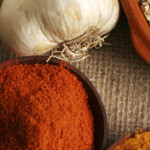Home > Blossary: The World of Moroccan Cuisine
Moroccan cuisine is the culinary star of North Africa. Imperial and trade influence has been filtered and blended into Morocco's culture. Being at the crossroads of many civilizations, the cuisine of Morocco is a mélange of Arab, Berber, Moorish, French, Middle Eastern, Mediterranean African, Iberian, and Jewish influences. Moroccan cooking is enhanced with fruits, dried and fresh -- apricots, dates, figs, and raisins, to name a few. Lemons preserved in a salt-lemon juice mixture bring a unique face to many Moroccan chicken and pigeon dishes. Nuts are prominent; pine nuts, almonds, and pistachios show up in all sorts of unexpected places. Moroccan sweets are rich and dense confections of cinnamon, almond, and fruit perfumes that are rolled in filo dough, soaked in honey, and stirred into puddings. The cooks in the royal kitchens of Fes, Meknes, Marrakech, Rabat and Tetouan refined Moroccan cuisine over the centuries and created the basis for what is known as Moroccan cuisine today. Spices are used extensively in Moroccan food. While spices have been imported to Morocco for thousands of years, many ingredients, like saffron from Taliouine, mint and olives from Meknes, and oranges and lemons from Fes, are home-grown. Common spices include karfa (cinnamon), kamoun (cumin), kharkoum (turmeric), skingbir (ginger), libzar (pepper) , tahmira (paprika), anis seed, sesame seed, kasbour (coriander), maadnous (parsley), zaafrane beldi (saffron) and mint.
Category: Food
1 Term
3
Created by: Marouane937
Number of Blossarys: 58
My Terms
Collected Terms
Estonian (ET)
Compare Language
Tajines Maroko kööki on aeglane keedetud stews hautatud madalatel temperatuuridel, mis tender liha kaste ja aromaatsed juurviljadega. Traditsiooniliselt küpsetatud tajine potti, mille kate on ...
Domain: Food (other); Category: Functional food
1 of 1 Pages 1 items


 Estonian (ET)
Estonian (ET) 